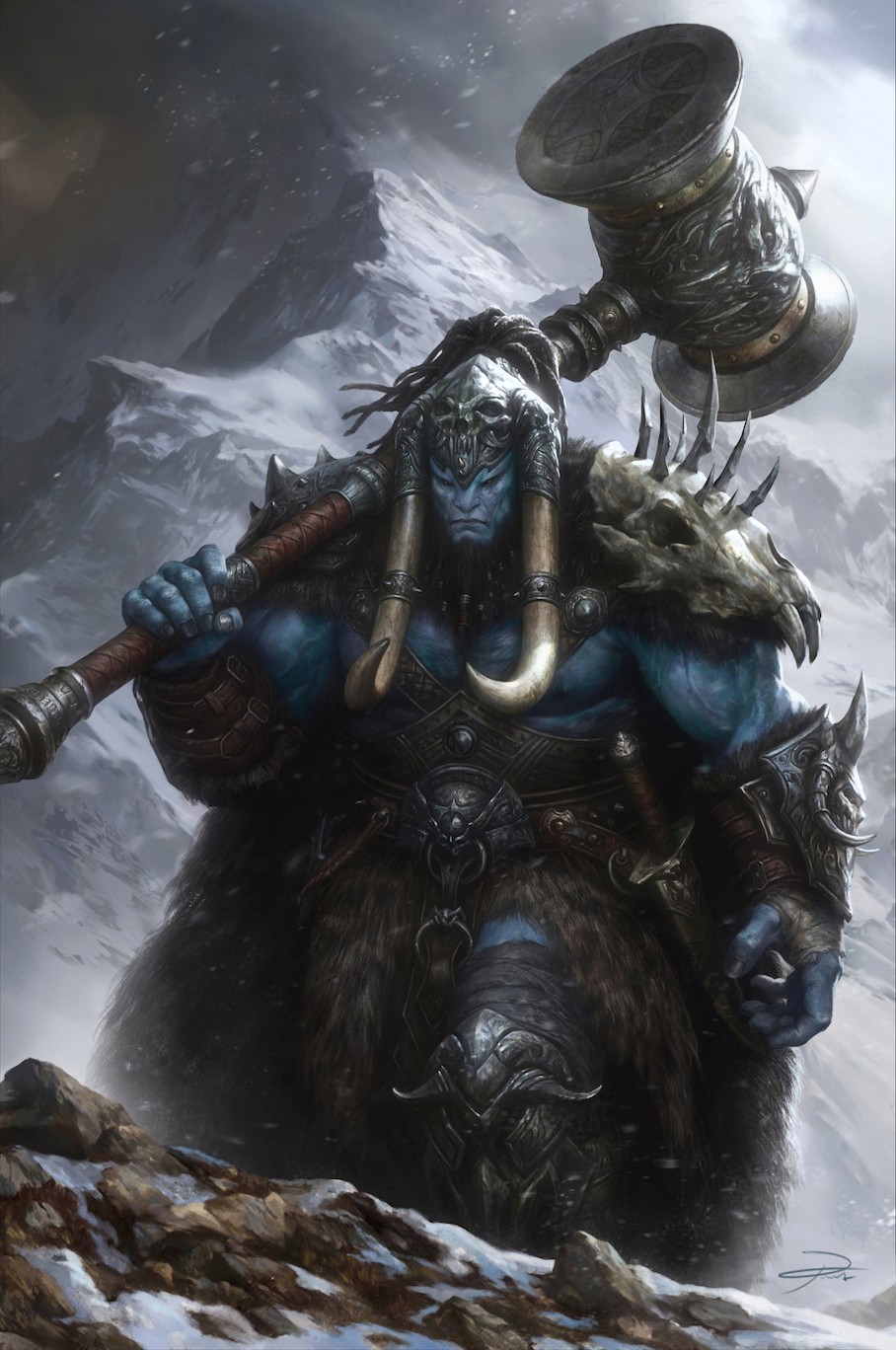
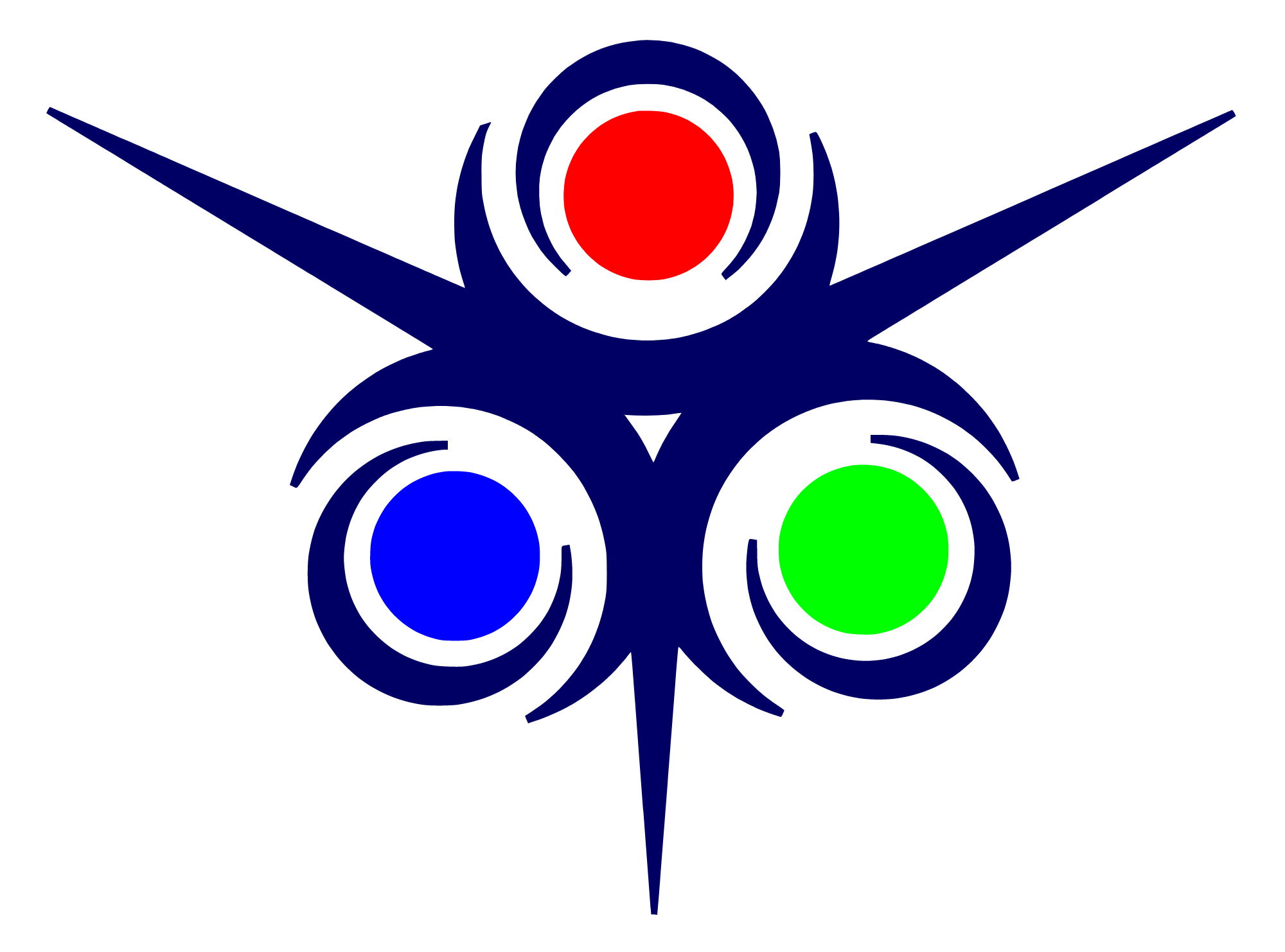

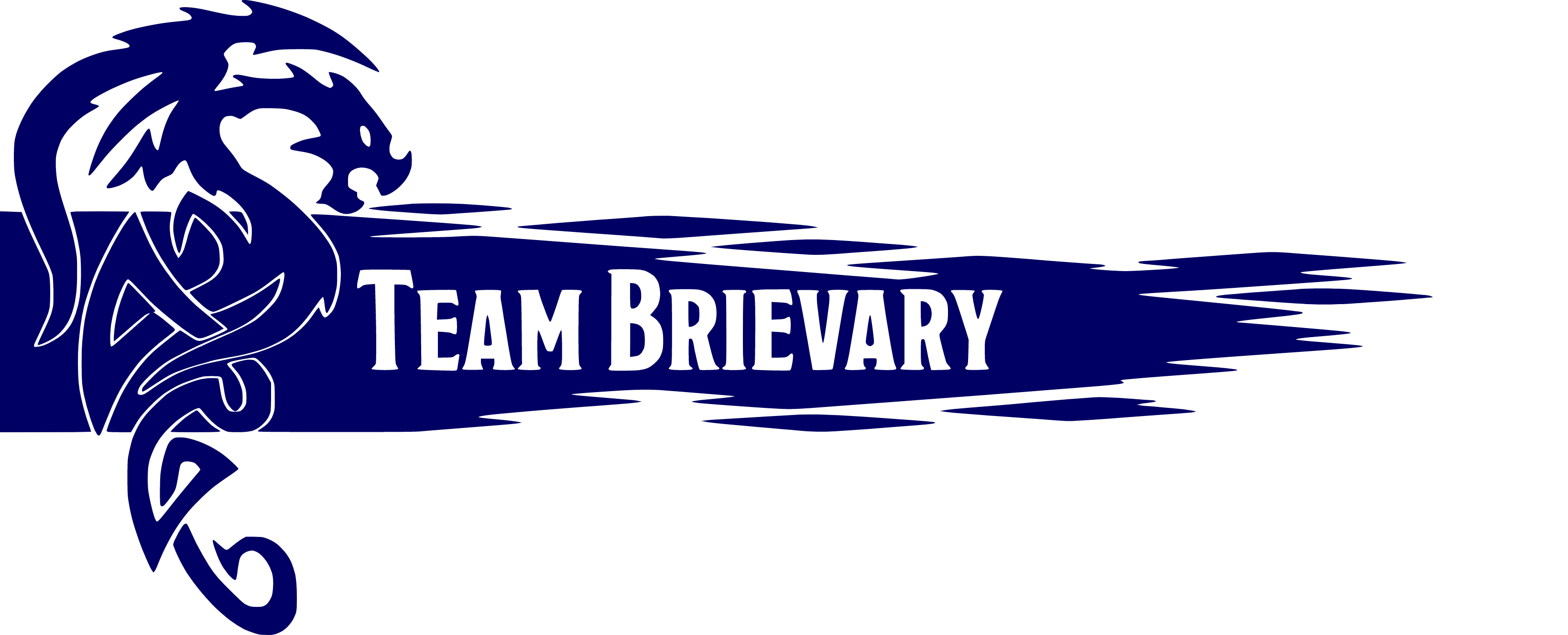
Giants
Behemoths of the mortal worlds, and the founders of civilization. Before there were dwarves, gnomes, elves, halflings and human, two races populated the world, the giants and the dragons. When the realms were new, and the sun had yet to shine on the mortal planes, the gods promised their children the right to the mountains and oceans that had formed in the material planes. The mistake that was made, was that the gods who made these promises never relayed the information to others, and so the giants and dragons were placed into the realms without the knowledge of the others presence, at least, until they made contact and all out war broke.
The Grilarstór War. During the 0th Era, otherwise known as the Ingens Era, the gods placed their children upon the mortal realms Muncaelo, Sanctus, and Relicta, as a gift to their ultimate creations, hoping to bear witness to the growth of their children as they too created and transformed the realms. However, when the children of the god--the dragons and giants--came into contact with each other, they entered a bloody war that would last 1500 years, and become known as the Grilarstór War.
The war wrought destruction across the realms, creating mountain ranges, ripping continents apart, and bringing about the creation of the several ancestral races, including the dervern, and the The Scalnatus, who would evolve to become dwarves and dragonborn, amidst other offshoots. While most forget the finer details of the wars today, and the first giants of Asguard retain the histories with failing memories, all that is well remembered was that Draco came down from the heavens to wipe the giants out, his legions upon failure were then used to forge the first cursed blade of victory; Draco's Folley, A dwarf betrayed the giants, allowing for the dragon queen to escape from death, and subsequently was cursed and turned into a dragon by Odin himself, and that most of the sentient races, specifically humans, rose from the blood and destruction of the war, and became the dominant races of the Material Realms.
More than the Six
Ask about the many citizen residing in the town and villages of the realms what giants there are, and you'd hear of the original six--cloud, fire, frost, hill, stone, and storm--and other simple facts, though often misconstrued by the lack of experiences of those people. Ask a knowledgable man, or parhaps an experienced adventurer, and you'd hear of the giant kin--firbolgs, goliaths, and ogres--and learn that there are more giants than at first presented.
Like the fearsome dragons, there are many more giants than what is first presented with an introduction to the true giants. Their hierarchical structure expands to include other lesser known giants, such as the death, desert, forest, and jungle giants, and within the many giant races, variants such as the craa'ghoran, mountain, and phaerlin giants exist. Many variants and irregular giants exist within their ordered culture, however there are more who break away from the hierarchy and enact as opponents to the true giants, despite being giants themselves. These rare giants expand to include the likes of the eldrtich giants, the Geriviar, and the spriggans.

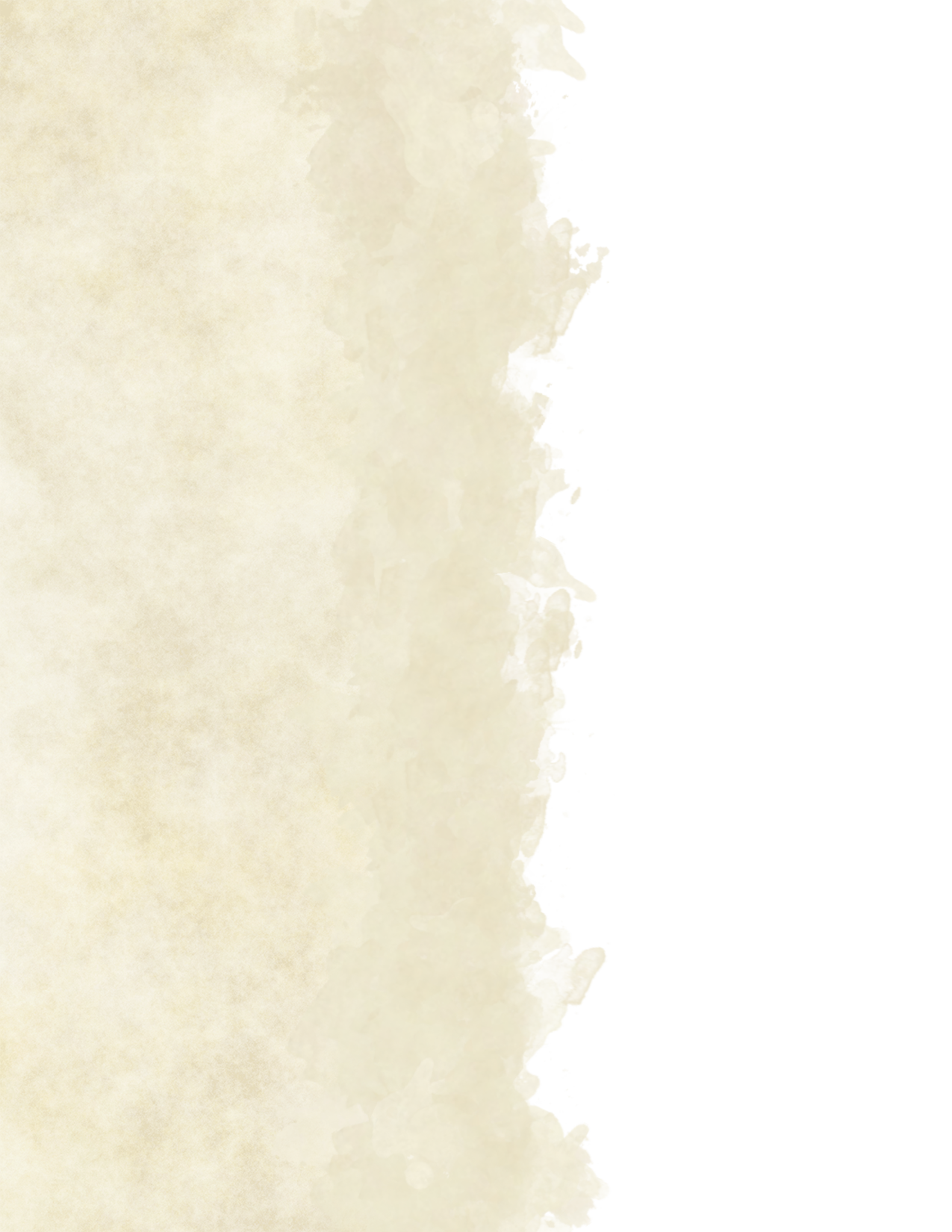
Cloud Shadow Giant
Huge giant, neutral good (50%) or neutral evil (50%)
- Armor Class 14 (Natural Armor)
- Hit Points 200 (16d12+96)
- Speed 40 ft.
STR DEX CON INT WIS CHA 27 (+8) 10 (+0) 22 (+6) 12 (+1) 16 (+3) 16 (+3)
- Saving Throws Con +10, Wis +7, Cha +7
- Skills Insight +7, Perception +7, Stealth +8
- Damage Resistances necrotic
- Senses darkvision 120 ft., passive Perception 17
- Languages Common, Giant
- Challenge 14 (11,500 XP)
Keen Smell. The giant has advantage on Wisdom (Perception) checks that rely on smell.
Living Shadow. While in dim light or darkness, the giant has resistance to damage that isn't force, psychic, or radiant.
Innate Spellcasting. The giant's innate spellcasting ability is Charisma. It can innately cast the following spells, requiring no material components:
At will: detect magic, fog cloud, light
3/day each: feather fall, fly, misty step, telekinesis
1/day each: control weather, gaseous form, darknessShadow Stealth. While in dim light or darkness, the giant can take the Hide action as a bonus action.
Sunlight Sensitivity. While in sunlight, the giant has disadvantage on attack rolls, as well as on Wisdom (Perception) checks that rely on sight.
Actions
Multiattack. The giant makes two morningstar attacks.
Morningstar. Melee Weapon Attack: +12 to hit, reach 10 ft., one target. Hit: 19 (3d8+8) piercing damage.
Rock. Ranged Weapon Attack: +12 to hit, reach 60/240 ft., one target. Hit: 30 (4d10+8) bludgeoning damage.
Shadow Giants
Shadow giants are giants that were either born in Malumtra or transformed by years spent within its dark domains. Some shadow giants embrace the Shadowfell for its desolate landscapes and dreary demeanor. Others seek to return to the Material Realms, to spread or escape the darkness of the Plane of Shadow.
Dark Portals. Portals to the Shadowfell manifest in forgotten caverns and the dark gloom of abandoned structures. The giants that explore such places often discover these portals and find themselves transported to the dark realm. Elder giants who would explore these locals might find themselves spirited away, never knowing that a portal had appeared and taken them away.
Recast in Shadow. The transformation to a shadow giant happens over a period of years, during which time a giant's skin loses it's pigment, fading to a gray or charcoal hue. Its hair become translucent and takes on a texture akin to wisps of shadows flowing from their heads, and its eyes paling to pools of opalescent grays and purples. Shadow giants find sunlight abhorrent, and they are weaker in bright light than they are in darkness. Malumtra also has a dispiriting effect on its denizens, such that the longer a creature remains on the plane, the more in tune with the planes distraught and unforgiving nature it becomes. As months and years pass for a giant on the Shadowfell, it becomes aware of the transformation being wrought upon it, and yet can do nothing to prevent it.
Back in the World. A shadow giant is so suffused with the power of the Shadowfell that even a return to a Material Realm can't undo their transformation. While some shadow giants will work to trick others into suffering the same destructive fate as themselves, other will leave the first chance they get, recognizing that living in the shadows of the mortal realms is still a better life than living within Malumtra.
Shadow Giant Template
Any giant can transform into a shadow giant, whether it is born in Malumtra or remains there for several years. When a giant becomes a shadow giant, it retains its statistics except as described below.
Damage Resistances. The giant has resistance to necrotic damage.
Skill Proficiency: Stealth. The giant's proficiency bonus is doubled for its Dexterity (Stealth) checks.
Living Shadow. While in dim light or darkness, the giant has resistance to damage that isn't force, psychic, or radiant.
Shadow Stealth. While in dim light or darkness, the giant can take the Hide action as a bonus action.
Sunlight Sensitivity. While in sunlight, the giant has disadvantage on attack rolls, as well as on Wisdom (Perception) checks that rely on sight.
Variant Elements. If the giant has a feature that deals acid, cold, fire, lightning, or poison damage , change that damage type to necrotic.
Craa'ghoran Giants
Craa'ghoran giants are the descendants of stone giants that were magically transformed by the elemental plane of earth and it's elementals.
More Stone Than Giant. The appearance of the craa'ghoran giants would lead one to mistake them for a completely different species of giant, or even go so far as to call them a cross between an undead and an elemental. The energies of the elemental plane withing them warp their bodies, treating it as untempered clays causing it to sag and sludge across their skeletons, while their chests and backs sprout stone spikes often to the point where a craa'ghoran natural balance is offset by their earthen growths.
Not all craa'ghoran giants suffer these physical defects, and the older giants who are more attuned to their powers are capable of forming a more solidified body, and even passing themselves off as normal stone giants.
Masters of Mazes. The craa'ghoran giants are a solitary species, preferring to live along away from other of their or any giant kin. the only exception to this rule is when craa'ghoran giants form small direct families, though one will never find more than four or five craa'ghoran giants living within close proximity. To maintain their solidarity, a craa'ghoran giant will seek out a large natural space of stone within the Material Planes, or the Elemental Plane of Earth, such as a vast mountain, or just beneath the surface of a vast untouched local.
When a craa'ghoran giant descides upon their territory, they will start to transform it into a vast maze. This is done for a variety of reasons, in part because the craa'ghoran as part elemental consume stone as a form of sustenance, and in part because their newfound control of the earth is well equipped for the construction of such large and sprawling structures. Beyond this, the craa'ghoran giants retain the love of artistry that is preeminent within stone giant culture, working this into their ever expanding mazes with beautiful murals covering their passageway wall, ornate statues housing within the many corners of their structures, and fine detailing permeating the bridges that cross the many caverns that the maze cuts through.
Many travelers stumble upon these boundless passages, mistaking them for uninhabited ruins, to be explored and looted. Unfortunately for them, craa'ghoran giants tend to find visitors very unpleasing, and soon any intruder will find themselves lost and in imminent threat of death at the giants hand. Some adventurers and merchants may try to barter safe passage through a craa'ghoran giants territory with a bribe, though in all likely hood, the giant will take the bribe and then renege on the deal soon after.
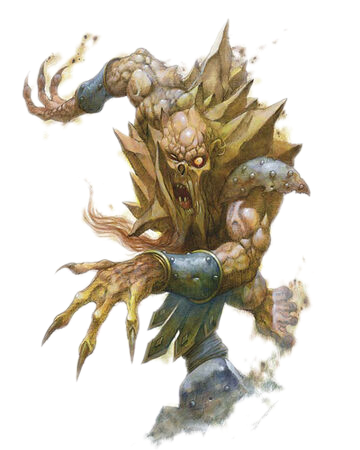
Craa'ghoran Giant
Huge giant, neutral evil
- Armor Class 17 (Natural Armor)
- Hit Points 127 (11d12+55)
- Speed 40 ft.
STR DEX CON INT WIS CHA 23 (+6) 15 (+2) 20 (+5) 10 (+0) 12 (+1) 9 (-1)
- Saving Throws Dex +5, Con +8, Wis +4
- Skills Athletics +12, Perception +4
- Damage Vulnerabilities thunder
- Damage Resistances bludgeoning, piercing, and slashing from nonmagical attacks
- Damage Immunities poison
- Condition Immunities poisoned
- Senses Darkvision 60 Ft., passive Perception 14
- Languages Giant
- Challenge 8 (3,900)
Innate Spellcasting. The giants's innate spellcasting ability is Charisma (save DC 10, +2 to hit with spell attacks). The giant can innately cast the following spells, requiring no material components:
At will: mold earth, wall of stone
3/day: earthquakeEarth Glide. The giant can burrow through nonmagical, unworked earth and stone. While doing so, the giant doesn't disturb the material it moves through.
Stone Camouflage. The giant has advantage on Dexterity (Stealth) checks made to hide in rocky terrain.
Actions
Multiattack. The giant makes two greatclub attacks.
Greatclub. Melee Weapon Attack: +9 to hit, reach 15 ft., one target. Hit: 19 (3d8+6) bludgeoning damage.
Rock. Ranged Weapon Attack: +9 to hit, reach 60/240 ft., one target. Hit: 28 (4d10+6) bludgeoning damage. If the target is a creature, it must succeed on a DC 17 Strength saving throw or be knocked prone
Reaction
Rock Catching. If a rock or similar object is hurled at the giant, the giant can, with a successful DC 10 Dexterity saving throw, catch the missile and take no bludgeoning damage from it.
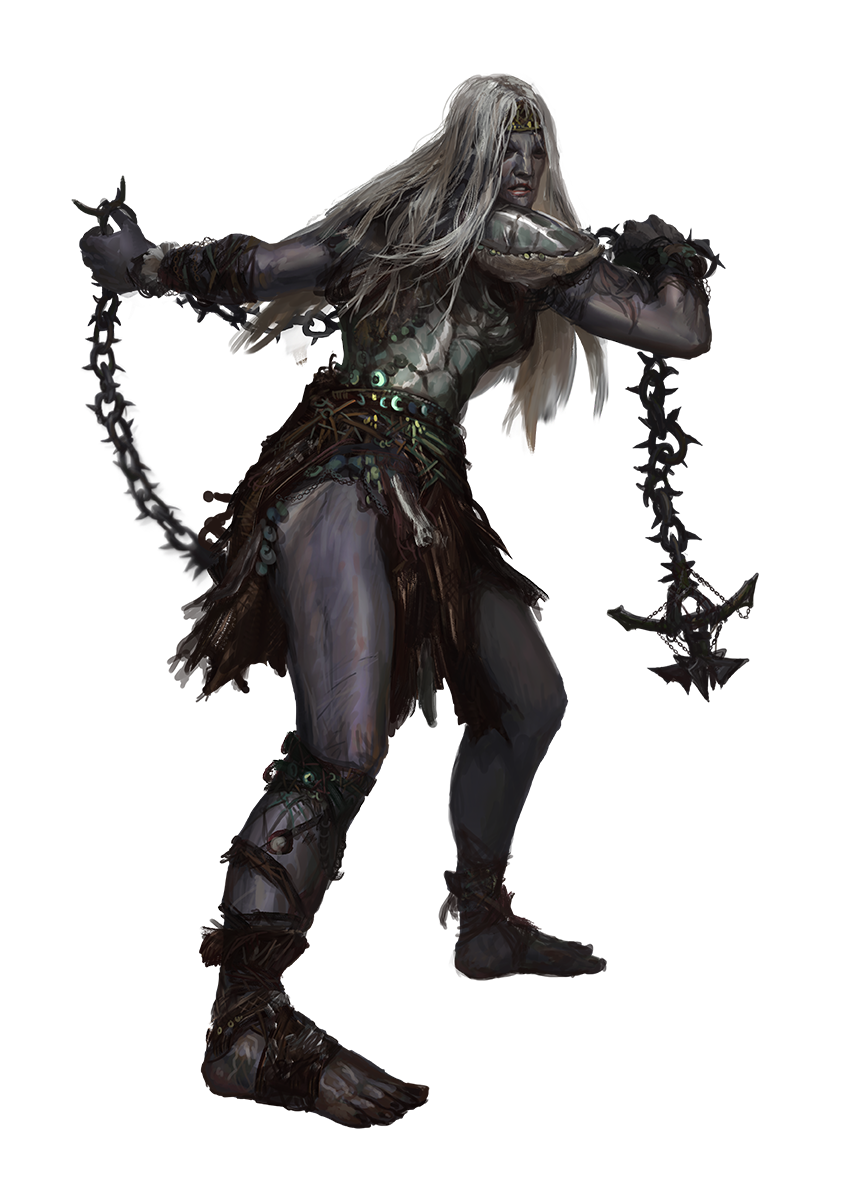
Death Giants
Collectors of lost souls, death giants traverse between Malumtra, Limbo, and the Material Realms to collect any and all souls for their own purposes. Before the appearance of the goddess of the dead, the first death giant--Hel--was the collector of all souls. During the Grilarstór War, she collected any and all souls of the deceased and, using a technique she acquired through nefarious means, empowered herself, becoming the first goddess of the dead, and overshadowing all other children of the gods, while preventing the souls she collected from reaching their proper afterlives.
Withdrawn from the Hierarchy. After achieving divinity, Hel taught her children the secrets of manipulating the souls their swore to collect, tainting the death giants, but causing them to grow in power. While they, for a time, grew to be more powerful than any other giants or dragons, they refused to participate in the Grilarstór War, suggesting that their job of collecting souls was all that matters, and that they held no stake in who one between the giants and the dragons.
Eventually though, their desire for more powerful souls lead them to manipulate the actions of both sides of the war, leading the the deaths of several prominent giants and dragons, and catching the eye of the giant king Odin. Once Odin was made wise to the actions of Hel to consolidate more power by leading her own kin to their deaths, he decided to take action, partitioning the gods to strip her of her divinity, and then sealing the majority of her powers himself, trapping her true body within a new realm, that now acts as her prison. Following this turn of events, Odin exiled the death giants, forcing them to fend for themselves, and creating the first of the renegade giant tribes, of many to come.
Adapted to Exile. After their exile from Giant Society, and the subsequent imprisonment of their only leader, the death giants were left to collect themselves and start a new society. Turning to magic, they adapted to their new predicaments, changing their bodies to be immune to the transformations of the shadowfell, and attaching their souls to that of Hel and her new prison, forever feeding her and assuring she did not die. Because of this, a death giants soul is not theirs, and they can't be revived after death, with their soul leaving to empower Hel in the hopes of one day being able to break free from her prison. However, the souls of the death giants alone were not enough, and while it will take eons to free Hel, it would take eons more if they did so through simple sacrifices of their kin, and thus the death giants returned to what they do best, collecting souls and empowering themselves.
Collectors of Souls. A death giants position within the death giant's society is determined by the amount of souls they have collected and infused into their bodies, with the greatest collectors being treated as leaders for the smaller clans. This in term feeds into empowering Hel from beyond her prison, with the empowered death giants souls going to Hel's new realms; the death giant afterlife, where only the souls of the death giants may go.
Death Giant Chain Reapers
While most of the death giants are focused purely on the collection of souls, the exceptional few dedicate themselves to following in the ways of Hel, empowering themselves and taking up chains to bind the souls they take.
Hunters in Sight. While it is common for death giants to seek other creatures to slay and collect souls, a death giant chain reaper will excel in the task, gaining power quickly, and seeking targets to slay, fearing next to no consequences.
While often a bit more brutish than other death giants, the chain reapers required success elevates their confidence, causing them to risk hunting in more dangerous local, and often targeting small to mid sized settlements within the Material Realms. This has the strange side effect of having more people see death giant chain reapers than death giants n general, as the actions of the chain reapers are often accounted by many survivors, where regular death giants target smaller groups, and leave less evidence of their presence behind.
Death Giant
Huge giant, neutral evil
- Armor Class 17 (chain mail)
- Hit Points 230 (20d12+100)
- Speed 50 ft.
STR DEX CON INT WIS CHA 28 (+9) 13 (+1) 21 (+5) 12 (+1) 17 (+3) 18 (+4)
- Saving Throws Con +9, Wis +7, Cha +8
- Skills Arcana +5, History +7, intimidation +8, Perception +7
- Damage Resistances cold; bludgeoning, slashing and piercing damage from non magic weapons
- Senses darkvision 60 ft., passive Perception 17
- Languages Common, Giant
- Challenge 12 (8,400 XP)
Innate Spellcasting. The giants's innate spellcasting ability is Charisma (save DC 16, +8 to hit with spell attacks). The giant can innately cast the following spells, requiring no material components:
3/day: dispel magic, inflict wounds, blight
1/day: flame strikeSoul Healing. The giant is immune to necrotic damage, and instead is healed by it. for every point of necrotic damage dealt to the giant, add the damage to its hit points.
Sold Soul. A death giant cannot be raised, resurrected, or reincarnated. A death giant's soul is utterly destroyed 1 round after the giant's death.
Actions
Multiattack. The giant makes two greataxe attacks.
Greataxe. Melee Weapon Attack: +13 to hit, reach 5 ft., one target. Hit: 26 (5d6+9) slashing damage.
Rock. Ranged Weapon Attack: +13 to hit, reach 60/240 ft., one target. Hit: 31 (4d10 + 9) bludgeoning damage.
Frightful Keening. The souls around the giant give off a frightening presence. Each creature of the giant's choice that is within 120 feet of the giant and aware of it must succeed on a DC 19 Wisdom saving throw or become frightened for 1 minute. A creature can repeat the saving throw at the end of each of its turns, ending the effect on itself on a success. If a creature's saving throw is successful or the effect ends for it, the creature is immune to the giant's Frightful Keening for the next 24 hours.
Death Giant Chain Reaper
Huge giant, neutral evil
- Armor Class 17 (chain mail)
- Hit Points 230 (20d12+100)
- Speed 50 ft., fly 50 ft. (hover)
STR DEX CON INT WIS CHA 30 (+10) 14 (+2) 21 (+5) 14 (+2) 19 (+4) 20 (+5)
- Saving Throws Con +9, Wis +8, Cha +9
- Skills Arcana +6, History +8, Intimidation +9, Perception +8
- Damage Resistances cold, lightning, necrotic
- Damage Immunities poison; bludgeoning, piercing, and slashing from nonmagical attacks
- Senses darkvision 60 ft., passive Perception 18
- Languages Common, Giant
- Challenge 19 (22,000 XP)
Innate Spellcasting. The giants's innate spellcasting ability is Charisma (save DC 18, +10 to hit with spell attacks). The giant can innately cast the following spells, requiring no material components:
3/day: dispel magic, inflict wounds, blight
1/day: flame strike, power word killSoul Healing. The giant is immune to necrotic damage, and instead is healed by it. for every point of necrotic damage dealt to the giant, add the damage to its hit points.
Sold Soul. A death giant cannot be raised, resurrected, or reincarnated. A death giant's soul is utterly destroyed 1 round after the giant's death.
Actions
Multiattack. The giant makes three chain attacks.
Reaper's Chain. Melee Weapon Attack: +14 to hit, reach 20 ft., one target. Hit: 28 (7d4+10) slashing damage.
Frightful Keening. The souls around the giant give off a frightening presence. Each creature of the giant's choice that is within 120 feet of the giant and aware of it must succeed on a DC 20 Wisdom saving throw or become frightened for 1 minute. A creature can repeat the saving throw at the end of each of its turns, ending the effect on itself on a success. If a creature's saving throw is successful or the effect ends for it, the creature is immune to the giant's Frightful Keening for the next 24 hours.
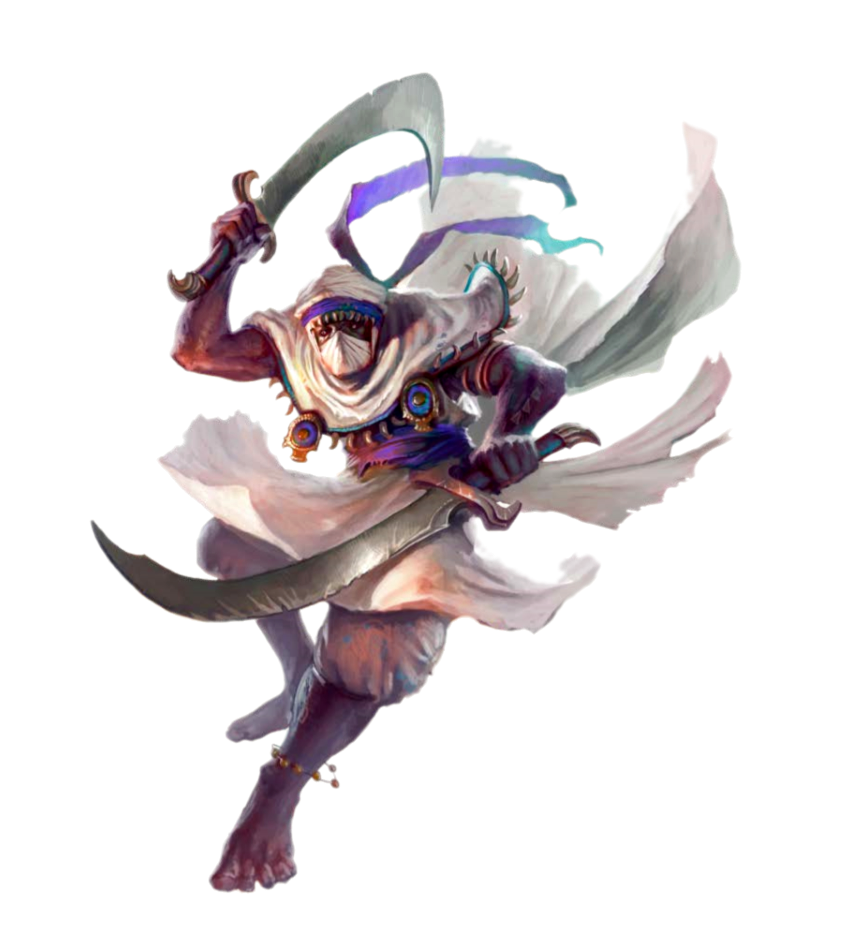
Desert Giant
Huge giant, neutral
- Armor Class 17 (Natural Armor)
- Hit Points 138 (12d12+60)
- Speed 40 ft.
STR DEX CON INT WIS CHA 22 (+6) 10 (+0) 21 (+5) 10 (+0) 12 (+1) 10 (+0)
- Saving Throws Str +9, Con +8, Cha +3
- Skills Perception +4, Stealth +3, Survival +4
- Senses passive Perception 14
- Languages Giant
- Challenge 7 (2,900 XP)
Desert Camouflage. The giant has advantage on Dexterity (Stealth) checks made to hide in desert terrain.
Actions
Multiattack. The giant makes two spear attacks.
Spear. Melee Weapon Attack: +9 to hit, reach 5 ft., one target. Hit: 16 (3d6+6) piercing damage.
Spear (Thrown). Ranged Weapon Attack: +9 to hit, range 60/180 ft., one target. Hit: 16 (3d6+6) piercing damage.
Desert Giant Sand Shifter
Huge giant, neutral
- Armor Class 17 (Natural Armor)
- Hit Points 175 (14d12+84)
- Speed 40 ft.
STR DEX CON INT WIS CHA 22 (+6) 10 (+0) 23 (+6) 11 (+0) 16 (+3) 13 (+1)
- Saving Throws Str +9, Con +8, Cha +4
- Skills Perception +4, Stealth +3, Survival +4
- Senses passive Perception 14
- Languages Giant
- Challenge 8 (3,900 XP)
Desert Camouflage. The giant has advantage on Dexterity (Stealth) checks made to hide in desert terrain.
Raise Ancestor. Once per week, a desert giant sand shifter can raise 4 (1d6) dead ancestors to aid it. the raised ancestors use the desert giant stat block, and fade into sand after 24 hours, or when their hit points hit 0, whichever may come first.
Actions
Multiattack. The giant makes two scimitar attacks.
Scimitar. Melee Weapon Attack: +9 to hit, reach 5 ft., one target. Hit: 20 (4d6+6) piercing damage.
Earthen Mount. The giant can mold the sand into a giant horse. when this horse is summoned, the giants size is gargantuan, and its speed is 120 ft. The giant also follow mounted combat rules.
Desert Giant
Gigantic shepherds of the wastelands, the desert giants are a nomadic species of giant found wandering the endless seas of sand and stone with their tribes and cattle. They cared little for outsiders, preferring to remain independent to their own tribes, and scarring off those who would oppose their wills.
Nomads. Desert giants are nomadic in nature. After the events of the Grilarstór War, the desert giants set off to settle the vast deserts of the Material Realms, and establishing a couple grand desert empires. These empires didn't last however, and the desert giants were cursed by the gods and broke into tribes who wander the planes of sand to this day.
In modern times, desert giants maintain free roaming cattle, following the herd and the rain to wherever they may find what they need to survive. Nomads would only settle down to wait out sandstorms, finding walled cities willing to let them shelter behind their walls for a short period of time, before taking off again to find new vegetation.
Lawless Lands. The desert giants took from the lands what was required to survive, and maintain their herds. They believe that the boons of the land--water, vegetation, spices and more--belong to whoever takes them, and see the farms and settlements of other races as nothing more than an obstacle.
Most people who live within these harsher landscpaes will ignore the actions of the desert giants, seeing them as a form of inescapable plague, and often bribing them with salt, cloth, spices, and metal to leave the lands be. While a few larger cities have employed adventurers to ward off the actions of desert giants, the size of a tribe and the strength of the giants often lead to battles being drawn out and bloody.
Mercenaries and Thieves. Not all desert giants remain with the tribe throughout the year. Young males will often leave their tribes for extended periods of time to act as mercenaries, guarding settlements, and sultans, or acting as both guards and guides for caravans making their way through the desert. Once they have completed several jobs, they'll return to their tribes with any boons they have earned and then distribute it among the people.
More often then that, younger members of a desert giant tribe that has come on hard times, or lost their herds, will use their natural ability to blend in with the desert terrain to set up ambushes. These ambushers will target any unlucky merchant or adventurer who stumbles into their trap, and plunder them of any resources the giants find to be useful to them.
From Flesh to Stone. When a desert giant nears the end of its lifespan, it start to turn into sandstone or salt. This is a curse placed upon the desert giants, by the gods for the misdeeds of their ancestors, and has been with the descendants of the desert giants for millenia.
Due to their inevitable, and unpreventable deaths, desert giants, upon witnessing the first sings of their decay into stone--their eyes turning brown--will migrate away from their tribes, leaving all but a few supplies and traveling towards the nearest desert giant burial grounds.
Once a desert giant has reached their final resting place, they will spend their last days resting amidst the stone bodies of their kin and tending or consuming the few cattle they take with them. Eventually, when the end has come, the desert giant will pick a spot and transform into a rocky pillar, never to revive again.
Desert Giant Sand Shifter
Among the desendants of the cursed desert giants, some are born with an innate control over it. These desert giant sand shifters are capable of summoning their dead bodies of their ancestors to fight battles for them, and can control the sands of the lands they wander to create creatures for them to ride into battle upon.
Sought or Shunned. Giants born with the powers of a sand shifter are rare amidst the tribes of the desert giants. Because of the spread of the desert giant culture, different tribes react to a desert giant sand shifter differently, with some tribes raising them to be leaders and protectors of the tribe, using their abilities to raise their dead to guard the new generations, while others reject sand shifter, viewing them as necromatic monsters who disrupt the remains of the dead.
Desert giant sand shifters who are rejected from their tribes may wander the deserts alone, maintaining their own private herds, or working with other races to survive, but more often than not, a sand shifter will settle in or near a desert giants graveyard, guarding the remains of the dead, using the stone pillars to ward off any intruders, and aiding any desert giants who come to settle down for their final days.
Controllers of the Curse. Desert giants born with the innate power to control the remains of the cursed ancestors do so through control of the curse itself. A desert giant sand shifters curse is actually hampered by their abilities, allowing them to temporarily release the curse on the corpses of the dead, and temporarily animate them, while also delaying the onset effects of the cure upon themselves. While most desert giants can only live to 400 years before the curse turns them to stone, a desert giant sand shift can live to 600 years, with some even staving off the curse beyond that.
Sand Riders. A desert giant sand shifters ability goes beyond reanimating the stony corpses of their dead however, and extend to full control over the sands they walk upon. Sand shifters can manipulate the particles of dirt to craft animalistic creatures for which they will ride. Reports even exist of a sand shifter who warred against a large city with an army of dead desert giants rider various horselike creates made entirely of sand.
Eldritch Giant
The forgotten brother of the storm giants, and the direct offspring of Odin, and his search for the wisdom of the worlds, the eldritch giants are formidable masters of swords and magic. Seeking out knowledge and creating powerful artifacts, these giants are one opponent even other giants would avoid fighting.
Arcane Seekers. As descendants of Odin, eldritch giants experience an unearthly drive to seek out the secrets of the realms, focusing on unraveling the many secrets of magic. To this end, eldritch giants would seek out ruins and temples to help with their personal research on spells, and collect forgotten magical relics, or they would take the time to craft their own magical items, as a means of manifesting their arcane knowledge or testing their magical hypothesis.
Their desire for knowledge leads them to live solitary lives, only ever interacting with other eldritch giants to share notes and ideas, but more often than not keeping their knowledge to themselves and hiding away in their studies or in long lost ruins. The eldritch giants were more likely to meet with settlements, seeking out materials that they themselves could not produce, then to meet with other eldritch giants.
Beyond this, eldritch giants also liked to collect lores, secrets of forgotten civilizations, and the stories of the happenings of the cosmos. To this end, many lore seekers would attempt to meet with the eldritch giants to try and learn their forgotten secrets, however while eldritch giants would conduct business with the settlements of humans and other humanoids, they didn't like to be bothered and would turn hostile if offended.
Runechild. The eldritch giants were created by Odin after his discovery of runes and their magical abilities. Using this newfound source of power, he crafted the verve rune as a powersorce and then made the first of the eldritch giants, based on the structure of the storm giants, the difference
Eldritch Giant
Huge giant, neutral evil
- Armor Class 18 (plate)
- Hit Points 230 (20d12+100)
- Speed 50 ft.
STR DEX CON INT WIS CHA 27 (+8) 14 (+2) 20 (+5) 20 (+5) 16 (+3) 18 (+4)
- Saving Throws Str +13, Con +10, Int +10, Cha +9
- Skills Arcana +10, Athletics +14, History +10, Perception +8
- Damage Resistances cold, lightning, thunder
- Damage Immunities force
- Senses passive Perception 18
- Languages Common, Giant
- Challenge 18 (20,000 XP)
Arcane Eyes. The giant is capable of discerning what is magic and what is not. the giants vision is constantly under the effects of the detect magic spell.
Innate Spellcasting. The giant's innate spellcasting ability is Intelligence (spell save DC 18, +10 to hit with spell attacks). It can innately cast the following spells, requiring no material components:
At will: dispel magic (5th level), magic missile (2nd level)
3/day: dimension door
1/day each: globe of invulnerability, magic weapon (6th level), shield
Magic Resistance. The giant has advantage on saving throws against spells and other magical effects.
Actions
Multiattack. The giant makes two greatsword attacks.
Greatsword. Melee Weapon Attack: +13 to hit, reach 10 ft., one target. Hit: 29 (6d6+8) slashing damage.
Rock. Ranged Weapon Attack: +13 to hit, range 60/240 ft., one target. Hit: 34 (4d12+8) bludgeoning damage.
Arcane Strike (Recharge 5–6). The giant releases a magical bolt at a point it can see within 500 feet of it. Each creature within 10 feet of that point must make a DC 18 Dexterity saving throw, taking 54 (12d8) force damage on a failed save, or half as much damage on a successful one.
Variant: New Giant Options
Some adult eldritch giants can channel arcane power through their bodies and release it with a destructive stomp. This ability is represented by the following action option.
Eldritch Stomp (Recharge 6). The eldritch giant stomps the ground, releasing a wave of eldritch energy. All other creatures within 15 feet of the giant must succeed on a DC 18 Constitution saving throw or take 33 (6d10) force damage. On a successful save, a creature takes half as much damage.
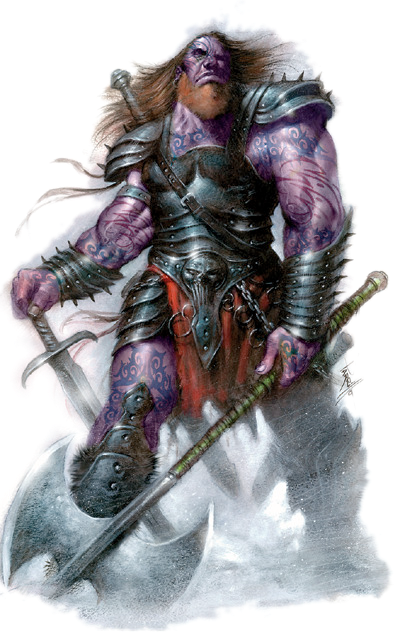
is their connection to the verve rune granted them powers over magic that normal storm giants didn't have, and caused their skin to grow purple and eltricth birthmarks to appear across their bodies.
Odin had hoped these new giants would act as a more powerful replacement for the storm giants during the Grilarstór War, however his own destructive desire for the truth was indicative of the nature of his new creations, and despite being powerful, the eldritch giants shunned the waring nature of the children of gods, and abandoned the giant clans to act upon their own desires, sometimes even trading information with the dragons, causing many giants to see them as a threat to themselves.
Cousins of Thunder. Being created by the first storm giants as an improved version of themselves, the eldritch giants shared a lot of similarities with that of the storm giants, including similar constitutions, strengths and wisdom of the elder storm giants. Even so, the eldritch giants connection to the verve rune caused them to connect to the pure magical energy of the realms as opposed to the energies of the stormy skies.
At first, this difference did not lead to too much enmity between the storm giants and this newly created race, but when the eldritch giants stared to show signs of disrespect to those who came first, and started to show their true capabilities, the storm giants--lead by Thor--sought to eradicate the eldritch giants to eliminate the new potential threat of them changing the hierarchy of the giant races and removing the power of storm giants.
This, paired with the trading of information between the eldritch giants and dragon was used as an excuse, and the eldritch giants were hunted down as traitors and removed from the greater giant society. The eradication wasn't all too successful, thanks in part to the great strength of the eldritch giants, but feeling abandoned by Odin, and no longer a part of the giants culture, the eldritch giants made it a point to kill any storm giants they come across, and a never ending message to those who betrayed them.
Forest Giant
Forest giants are benign, nature loving caretakers who maintain and nurture the forests they live within. Allied with the elves, forest giants will create animal sanctuaries, protecting the wildlife from hunters and growing the plantlife within these giant, natural gardens.
Guardians of the Woods. When the averians--ancestors of the elves--first entered the Material Realms, they aligned themselves with the newly independent forest giants, living amidst their terrain and impacting each others culture to the point where the will of nature became more important than the bickerings of giants and dragons to the likes of the forest giants. While still apart of the giant hierarchy, the forest giants rank lower than the likes of the hill giants due to their disposition and dislike of the greater actions of the giant races, preferring to maintain their territories and work together with the smaller races as opposed to causing ruckuses and fighting for strength.
Nowadays, it is most common to find a forest giant within a secluded thicket of woods, or living nearby some sort of natural grove. Forest giants don't live together, only doing so to raise kids until adulthood, and live individually nearby these natural locations. While forest giants are by no means completely solitary creatures, often living and interacting with druids and elves, they as a people have determined that spreading their influence is the best way to maintain the environments they protect.
Serene. Forest giants are peace keepers by nature. Their beliefs to the forest cause them to view humanoids as another creature that needs direction and upkeep. Because of this, forest giants are not hostile, and will leave fighting to the last option. Do not mistake this for infinite patience however, as if a forest giant believes they have been greatly slighted, or that their domain they protect is in danger, they will forsake their peaceful ways and decimate any opponents they may meet, even if they are other giants.
Beyond this, most forest giants are primarily herbivores. While they are capable of eating meet, their preference to avoid killing leads them to limited dietary options. To prevent themselves from starving, they maintain certain editable plants and supplement the rest of their livelihoods with magic. This has the adverse effects of shortening their lifespans, causing forest giants to be one of the most short-lived of the giant races, often making it no longer than 150 years.
Forest Giant Prognosticator
While most forest giants find them selves in tune with nature and protecting it, some go a step farther, communing with it, and becoming druids. These giants are revered as elders and exemplars within forest giant culture, and many hope to one day achieve this level of coexistence with the gardens they tend to.
Holistic Endeavors. While many forest giants guard their patches of woods as outsiders and controllers, a forest giant Prognosticator will often attune themselves to the forest itself, only acting when they feel that inactivity is most imperative. Beyond this, they let the cycles of their garden progress naturally, with plants and animals dying as death comes for them, and new life growing from what is left behind. Some forest giant prognosticators will even allow the wisps of flame to engulf their homes in wildfires if they believe it is time for a rebirth of the land, allowing the nutrients of the charred wood to start growing anew.
Masters of Nature. Although they prefer to remain inactive, allowing the progression of the forests they call home to follow their natural paths, forest giant prognosticators can enforce their will on the plant-life they surround themselves in. Using this innate understanding of the fauna and flora they connect with, they can enact magic to combat and control, and even see into the future.
They use these skills to prepare for up[coming events, coming to grips with the way the world is to be. Some who attain this power will act more stern and cave to their desire to protect their homes, but these prognosticators are few and deemed as improper by their peers.
Forest Giant
Huge giant, neutral
- Armor Class 14 (leather armor)
- Hit Points 147 (14d12+56)
- Speed 40 ft.
STR DEX CON INT WIS CHA 22 (+6) 16 (+3) 19 (+4) 10 (+0) 16 (+3) 18 (+4)
- Saving Throws Dex +7, Con +8, Wis +7
- Skills Nature +7, Perception +7, Stealth +7, Survival +7
- Senses passive Perception 17
- Languages Giant, Sylvan
- Challenge 8 (3,900 XP)
Forest Camouflage. The giant has advantage on Dexterity (Stealth) checks made to hide in forest terrain.
Actions
Multiattack. The giant makes two attacks with its spear.
Spear. Melee or Ranged Weapon Attack: +10 to hit, reach 15 ft. or range 60/240 ft., one target. Hit: 16 (3d6+6) piercing damage or 19 (3d8+6) piercing damage when wielded with two hands as a melee weapon.
Log. Ranged Weapon Attack: +10 to hit, reach 60/240 ft., one target. Hit: 28 (4d10+6) bludgeoning damage. If the target is a creature, it must succeed on a DC 17 Strength saving throw or be knocked prone.
In a given situation where a forest giant prognosticator finds that their only solution to a problem is to act, they will bring the forest itself to life, allowing the trees they live between to uproot themselves and take form, becoming treant like creatures that will combat anything they believe is a threat to themselves, their homes, and the forest giant prognosticator.
Frigga--mother of the forest giants--is one of, if not the most powerful of the forest giant prognosticators. During our brief tenure on the isle of Asgard, I was given the chance to talk with this fine giantess and tour her famous garden, where the golden apples are grown. There, I asked to bear witness to her innate connection with the natural order, to which I remember her chuckling before the entire garden uprooted itself and surrounded me.
-- Iorki P.
Forest Giant Prognosticator
Huge giant, neutral
- Armor Class 13
- Hit Points 147 (14d12+56)
- Speed 40 ft.
STR DEX CON INT WIS CHA 22 (+6) 16 (+3) 19 (+4) 16 (+3) 19 (+4) 18 (+4)
- Saving Throws Dex +7, Con +8, Wis +8
- Skills Arcana +7, Nature +8, Perception +8, Stealth +7, Survival +8
- Damage Resistances bludgeoning, piercing, and slashing from nonmagical attacks
- Senses passive Perception 18
- Languages Giant, Sylvan
- Challenge 11 (7,200 XP)
Forest Camouflage. The giant has advantage on Dexterity (Stealth) checks made to hide in forest terrain.
Innate Spellcasting. The giant's innate spellcasting ability is Charisma (spell save DC 16). It can innately cast the following spells, requiring no material components:
At will: detect good and evil, detect magic, locate animals or plants, mind spike
3/day each: foresight, true seeingActions
Multiattack. The giant makes two attacks with its staff.
Staff. Melee: +10 to hit, reach 15 ft. or range 60/240 ft., one target. Hit: 16 (3d6+6) bludgeoning damage or 19 (3d8+6) bludgeoning damage when wielded with two hands.
Animate Trees (1/Day). The giant magically animates one or two trees it can see within 60 feet of it. These trees have the same statistics as a treant, except they have Intelligence and Charisma scores of 1, they can't speak, and they have only the Slam action option. An animated tree acts as an ally of the giant. The tree remains animate for 1 day or until it dies; until the giant dies or is more than 120 feet from the tree; or until the giant takes a bonus action to turn it back into an inanimate tree. The tree then takes root if possible.
Geriviar
Gigantic beasts with an inherent rage towards structures, the geriviars are a rare breed of giant, not normally witnessed or even references amidst the hierarchical structure of the giants overarching society. Often living within secluded environments, the geriviar were often contracted to help armies to deal with fortified cities and other structures.
Pathological Rage. For reasons unknown by all but the gods and elder giants, the geriviars possess a strange, all consuming loathing for permanent structures of any kind. The sight of a structures, such as a tower of fortified wall pulls a rage from deep within their subconscious, and offends them on a personal level.
Paired with their inflexible, and stubborn personalities, the geriviars are known to immediately destroy any structures they come across, and those who built or reside within them. Unyielding in this pursuit of destruction, once a geriviar had set it's mind to something, death was usually the only means of stopping it, unless one with a will as strong as the geriviars were to step in.
Siege Engines Manifested. While it is unknown--the cause of the gerivars inherent hatred--it cannot be disputed that gerivars are the perfect siege weapons. Skilled in the dismantlement of structures such as siege towers and defensive walls, being able to convince a geriviar to aid your armies can act as a great boon for you, assuming you yourself do not use any fortifications while in the presence of the giant.
It should be recognized however, that while great aids in war, the geriviar themselves often avoid armor and weapons, fighting in a more primal style with their fists and their naturally produced nodules. Paired with their enhanced healing, one might mistake them for gigantic mindless beasts, if not for their capability to communicate when not in a blind rage.
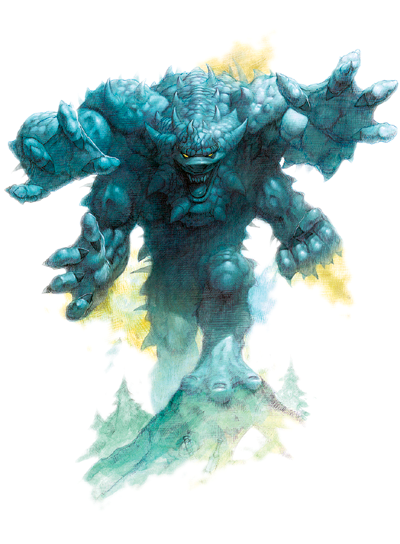
Geriviar
Huge giant, chaotic evil
- Armor Class 19 (natural armor)
- Hit Points 209 (16d12+105)
- Speed 70 ft.
STR DEX CON INT WIS CHA 30 (+10) 18 (+2) 24 (+5) 12 (+1) 10 (+0) 10 (+0)
- Saving Throws Str +17, Dex +9
- Damage Resistances bludgeoning, piercing, and slashing from nonmagical attacks that aren't adamantine
- Damage Immunities fire, poison, thunder
- Condition Immunities poisoned
- Senses passive Perception 10
- Languages Giant
- Challenge 21 (33,000 XP)
Innate Spellcasting. The giant's innate spellcasting ability is Charisma (spell save DC 15). It can innately cast the following spells, requiring no material components:
1/day: invisibility
Magic Resistance. The giant has advantage on saving throws against spells and other magical effects.
Siege Monster. The giant deals double damage to objects and structures.
Regeneration. The giant regains 10 hit points at the start of its turn. If the giant takes acid or cold damage, this trait doesn't function at the start of the giant's next turn. The giant dies only if it starts its turn with 0 hit points and doesn't regenerate.
Actions
Multiattack. The giant makes two slam attacks.
Slam. Melee Weapon Attack: +17 to hit, reach 5 ft., one target. Hit: 20 (3d6+10) bludgeoning damage.
Rock. Ranged Weapon Attack: +17 to hit, range 60/180 ft., one target. Hit: 32 (4d10+10) bludgeoning damage.
Explosive Nodules (3/day). The giant rips off one of its nodules and throws it at a spot with 30 ft. of it. All creatures within a 10 ft. radius of the nodules landing spot must make a DC 15 Dexterity saving throw, taking 18 (4d8) fire damage and 21 (6d6) piercing damage on a failed save, or half as much on a success.
Jungle Giant
Cousins to the forest giants, the jungle giants are descended from those who sought out other lands, disconnected from the ways of Freya and her kin, the jungle giants live in a more tribal society, living off the land and hiding amidst the tall tree, without the interactions that you would see from a normal forest giant.
Top of the Food Chain. Withing the southern jungles of Ildebadric continent, the jungle giants seek out prey to sustain themselves. Jungle giants are carnivores, seeking out and hunting any game they can find amidst the dense bush of the outback. While smaller creatures are less likely to be hunted, seeing as they are little more than a snack to the likes of a giant, large cats, lizards, and snakes are often hunted within an area until the giants decide to move onto locations with better game.
After they have skinned the creatures and consumed the meats, they utilize the bones and skins to craft themselves cloths and tools, often creating axes, spears and daggers out of them along with boulders and trees. With these tools, giants will set up large traps designed to incapacitate and kill their targets. Often carrying large knives with them, many jungle giants are trained to be efficient with their kills and work, allowing their lifestyle to be maintained.
Respect of the Hunter. Jungle giant--unlike most of the other giant kin-- prefer to work alongside the likes of humans and other humanoids. Often joining other humans for hunts, the jungle giants have garnered an appreciation for the sheer volume of humans, often working to have a large group chase off prey into the waiting ambush of the jungle giants. Because of these cooperative hunts, many jungle giants are sighted in the presence of human tribals.
Jungle giants respected the assistance of these littlefolk, and believe that any creature brave enough to participate in
the hunt was worthy of respect, no matter their size or race. If game became scarce, or the population of giants grew too large, many would wander from the jungles, heading to hunt in nearby safaris and grasslands, though their natural disadvantage in these locals would eventually lead them back to their preferred habitat.
Mountain Giant
Brutish cousins of the hill giants, the mountain giants are cruel and erratic hill giants that adapted to living within mountainous terrain over the course of generations. Often a little smaller than the likes of your typical hill giant, their reduced stature was made up by their extreme hardiness and strength, being capable of feats on par with the likes of the fire giants.
Civil Split. The clans who would give birth to the line of the mountain giants split off from the hill giant society in the later half of the first era. While specific records of these event have been lost through the generations, primarily to a lack of documentation and an inconsistent oral tradition maintained by both hill and mountain giants alike, both sides claim that the split was due to a civil war within the hill giants society, that inevitably ended with either the abandonment, or exile of the mountain giant forefathers.
Mountain Networks. Mountain giant clans would consist a several groups of small families living throughout a mountain rang, with each family being regulated to a single peak. Often lead by a shaman who leads the occasional gatherings of the families, and visitors who come seeking an audience with the tribe, the giants would share information between the families to help maintain their control over their shared territory.
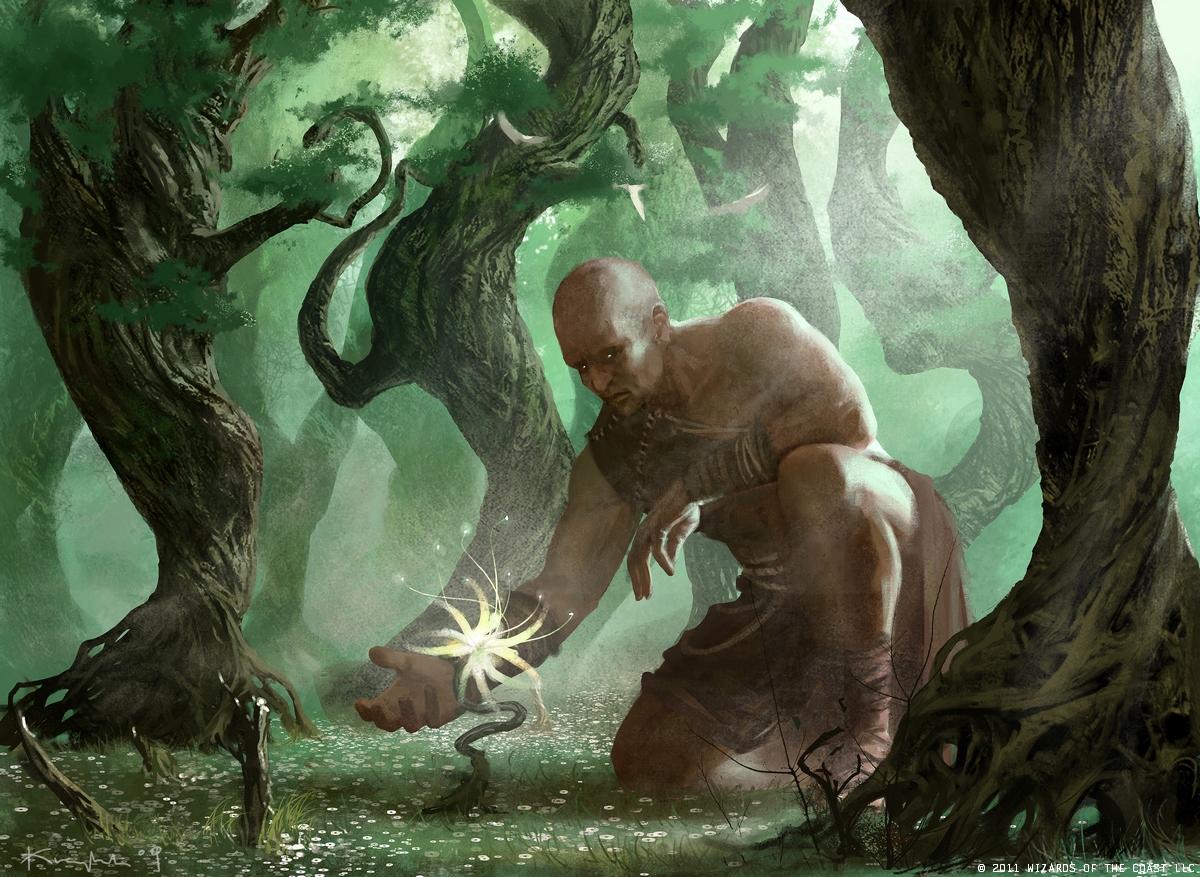
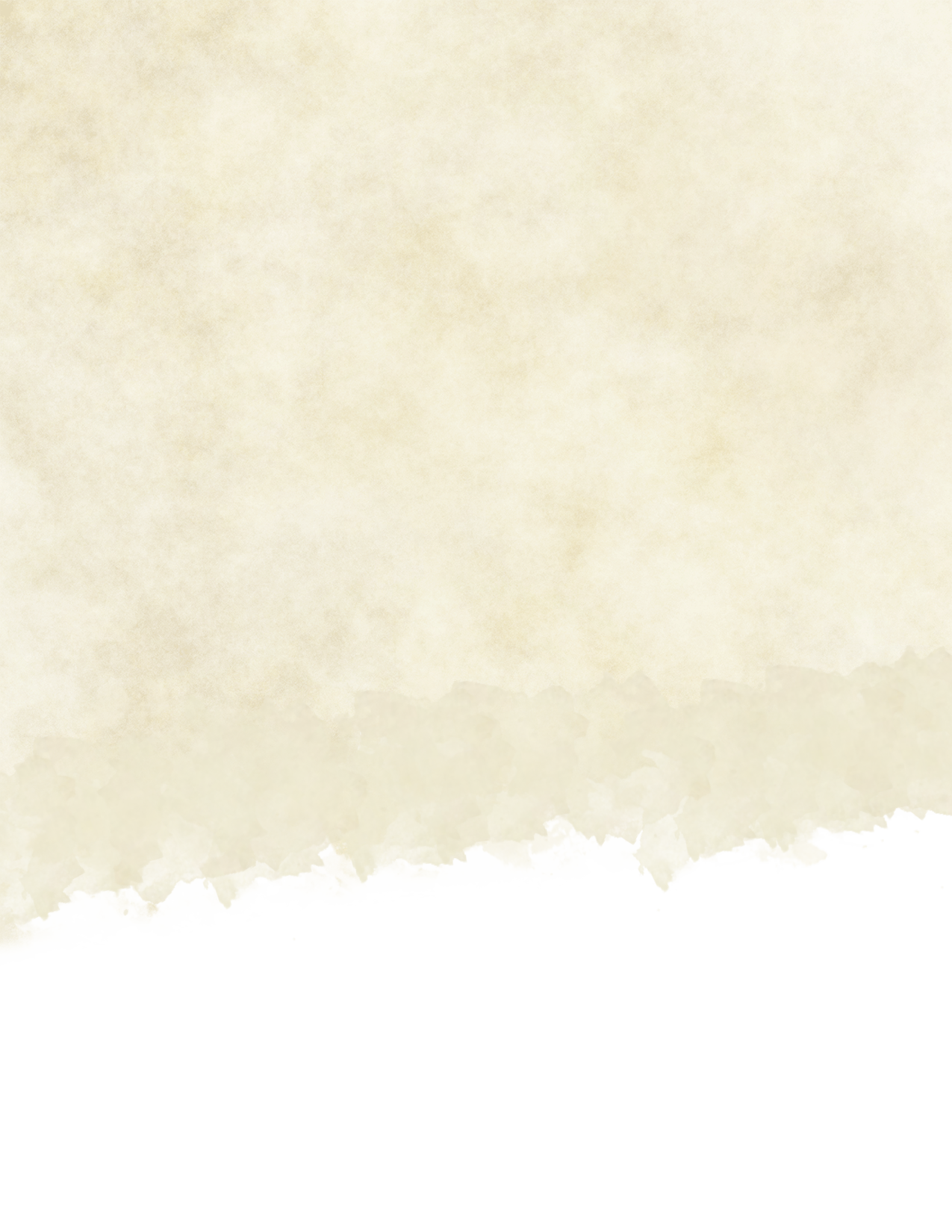
Jungle Giant
Huge giant, neutral
- Armor Class 14 (leather armor)
- Hit Points 147 (14d12+56)
- Speed 40 ft.
STR DEX CON INT WIS CHA 22 (+6) 16 (+3) 19 (+4) 10 (+0) 16 (+3) 18 (+4)
- Saving Throws Dex +7, Con +8, Wis +7
- Skills Nature +7, Perception +7, Stealth +7, Survival +7
- Senses darkvision 60 ft., passive Perception 17
- Languages Giant, Sylvan
- Challenge 8 (3,900 XP)
Jungle Camouflage. The giant has advantage on Dexterity (Stealth) checks made to hide in jungle terrain.
Actions
Multiattack. The giant makes two attacks with its spear.
Dagger. Melee or Ranged Weapon Attack: +10 to hit, reach 5 ft. or range 20/40 ft., one target. Hit: 13 (3d4+6) piercing damage.
Giant Bow. Ranged Weapon Attack: +7 to hit, range 150/600 ft., one target. Hit: 13 (3d8+3) piercing damage.
Log. Ranged Weapon Attack: +10 to hit, reach 60/240 ft., one target. Hit: 28 (4d10+6) bludgeoning damage. If the target is a creature, it must succeed on a DC 17 Strength saving throw or be knocked prone.
Mountain Giant
Huge giant, chaotic evil
- Armor Class 15 (natural armor)
- Hit Points 126 (11d12+55)
- Speed 40 ft.
STR DEX CON INT WIS CHA 21 (+5) 8 (-1) 20 (+5) 9 (-1) 9 (-1) 10 (+0)
- Skills Perception +2
- Senses passive Perception 12
- Languages Giant
- Challenge 5 (1,800 XP)
Domineering Words. Mountain giants are skilled at convincing other creatures to do work for them. The giant has advantage on all Charisma checks to persuade or command beasts, monstrosity, swarm of tiny beasts, and even some types of giants (hill giants, ogres, and trolls).
Keen Smell. The mountain giant has advantage on Wisdom (Perception) checks that rely on smell.
Actions
Multiattack. The giant makes two greatclub attacks.
Greatclub. Melee Weapon Attack: +8 to hit, reach 10 ft., one target. Hit: 18 (3d8+5) bludgeoning damage.
Rock. Ranged Weapon Attack: +8 to hit, range 60/240 ft., one target. Hit: 21 (3d10 + 5) bludgeoning damage.
It is in the best interest of any adventurers and other typical travelers who enter the territory of a mountain giant tribe to seek out an audience with the shaman, as most other mountain giants will attack or rob you outright otherwise.
When discussing previous incidents my daughter has experienced, specifically a mission I sent her on to make contact with the giant tribe of the dragons spine, I was intrigued to learn how commutative, and cooperative the mountain giants turned to be.
She had stated that their leader was one who communed with the creatures of the mountain, capable to bending them to his will, but looking out for them all the same. It seems like further communication can continue, and a deal with the giant tribes can be struck.
-- Iorki P.

Phaerlin Giant
Huge giant, neutral
- Armor Class 18 (natural armor)
- Hit Points 202 (13d12+78)
- Speed 50 ft.
STR DEX CON INT WIS CHA 23 (+6) 15 (+2) 22 (+6) 7 (-2) 12 (+1) 15 (+2)
- Saving Throws Dex +5, Con +8, Wis +4, Cha +5
- Skills Athletics +12, Perception +4
- Senses blindsight 60 ft., darkvision 120 ft., passive Perception 14
- Languages Giant
- Challenge 9 (3,900 XP)
Stone Camouflage. The giant has advantage on Dexterity (stealth) checks made to hide in rocky terrain.
Keen Smell. The giant has advantage on Wisdom (Perception) checks that rely on smell.
Actions
Multiattack. The giant makes two attacks, one with its bite, and on e with its claws.
Bite.* Melee Weapon Attack:* +9 to hit, reach 5 ft., one target. Hit: 16 (3d6+6) bludgeoning damage.
Claws. Melee Weapon Attack: +9 to hit, reach 10 ft., one target. Hit: 13 (3d4+6) bludgeoning damage.
Rock. Ranged Weapon Attack: +9 to hit, range 60/240 ft., one target. Hit: 28 (4d10 + 6) bludgeoning damage. If the target is a creature, it must succeed on a DC 17 Strength saving throw or be knocked prone.
Frightful Howl (Recharge 6). Each creature that is within 120 feet of the giant and can hear it must succeed on a DC 15 Wisdom saving throw or become frightened for 1 minute. A creature can repeat the saving throw at the end of each of its turns, ending the effect on itself on a success. If a creature's saving throw is successful or the effect ends for it, the creature is immune to the giant's Frightful Howl for the next 24 hours.
Phaerlin Giant
The phaerlin giants were migratory stone giants who moved deep into the underdark. Hunched over due to the restraining space of the many caves, and often crawling on all fours as opposed to standing, the phaerlin were mutated and adapted to survival in the harsh environment of the underdark, abandoning their reason, and becoming a feral monstrosity to be feared withing the howling caves where the light doesn't shine.
Ancient Prisoners. Long ago, the stone giants who would come to be the first of the phaerlin were enslaved, and imprisoned by the drow, treated as large brutes forced to perform tasks within mines, creating new tunnels and structures, and fending off monster attacks for their new masters. Their presence helped the drow to eventually create a permanent foothold within the underdark that has proven to be resilient to this day.
This slavery would not end however, and eventually lead to drow experiments with dark magic being performed on the phaerlin to enhance more desired features for combative purposes, as well as dumb them down to make them easier to control. These experiments failed in the end, and the resulting mutations would bee seen within the phaerlin for generations to come.
Solitary Beasts. Eventually, some of the phaerlin broke free from their restraints and ran with wild abandon into the winding tunnels to be unseen for years. While these wild phaerlin have reproduced--making them a normal part of the underdarks ecosystem--they are a rare species, living solitary lives of hunting and having low numbers.
On rare occasions, two to three phaerlin would cooperate, but this was always temporary, and they would soon after return to what would be their marked territories. This is consistant with most interactions with the phaerlin who, while sentient, were barley capable of speech, and held no culture. This incapability of forming social connections and repressing their instinctual desires prevented them from ever leaving their dark homes and returning to the society of other stone giants, furthering the divide between the two now distinct species.
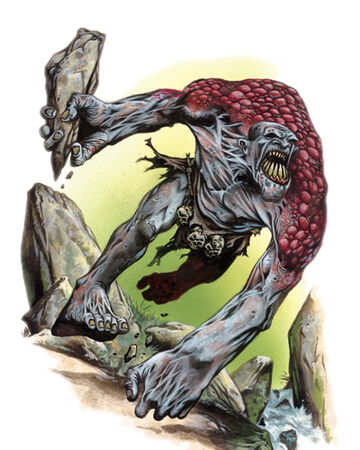
Spriggan
Medium fey, chaotic neutral
- Armor Class 17 (natural armor)
- Hit Points 190 (20d8+100)
- Speed 30 ft.
STR DEX CON INT WIS CHA 18 (+4) 13 (+1) 20 (+5) 10 (+0) 16 (+3) 12 (+1)
- Skills Animal Handling +4, Perception +6
- Damage Vulnerabilities fire
- Damage Resistances bludgeoning, piercing
- Senses passive Perception 16
- Languages Giant, Sylvan
- Challenge 7 (2,900 XP)
False Appearance. While the spriggan remains motionless, it is indistinguishable from a normal tree.
Innate Spellcasting. The spriggan's spellcasting ability is Wisdom (spell save DC 14, +6 to hit with spell attacks). The spriggan can innately cast the following spells, requiring no material components:
At will: enlarge/ reduce (targeting self), flesh to stone (wood)
1/day each: detect magic
Magic Resistance. The spriggan has advantage on saving throws against spells and other magical effects.
Magic Weapons. The spriggan's weapon attacks are magical.
Actions
Multiattack. The spriggan makes two claw attacks.
Claws. Melee Weapon Attack: +7 to hit, reach 5 ft., one target. Hit: 11 (2d6+4) slashing damage.
Children of the Forest (1/Day). The spriggan magically calls 2d4 swarms of wasps, ravens, beetles, or rats. While outdoors, the spriggan can call 3d6 wolves instead. The called creatures arrive in 1d4 rounds, acting as allies of the spriggan and obeying its spoken commands. The beasts remain for 1 hour, until the spriggan dies, or until the spriggan dismisses them as a bonus action.
Spriggan
The spriggans were a race of giants abandoned in the feywilds by the giant kin during the Grilarstór War. Ghosts of their former selves, the arcane energies and curse of the fey have transformed them into living trees, guarding treasures and playing pranks upon any who accidentally wader into their territories.
Forgotten Giants. In times forgotten, the spriggan were giantkin, weaker than the likes of the firbolg and goliaths with whom the spriggan were closer to within the ordning. During the war between giants and dragons, the spriggan were positioned within the feywild, seeking allegiances on behalf of the storm giants from the fey lords that resided there.
Unfortunately, the Spriggan were abandoned by their kin within Mystramm, and over generations of missteps with the courts of the fay, and the magics of the realm, they were transformed into the tree-like humanoids they appear as today, abandoning the giantkin outright in anger of the betrayal they feel, and acting against the natural denizens of the realm they now call home as petty revenge for the curses that have permanently transformed their species from the powerful beings they once were to the musks of wood they have become.
Grudge-Bearers. With a history wrought with betrayal and malefactors, the generations of spriggan grew up learning and inheriting the hatred of their ancestors towards all who have wronged them. Due to this form of upbringing, the spriggan hold an undying grudge against both fey and giants alike, and have grown to remember all accounts against them, and to pay people back, albeit in a more mischievous way more often than not.
Having found themselves more connected to the plant-life around them has helped to soothe their cultural anger over the years, changing them to be more fey-like themselves, with their desire to gain vengeance through simple pranks and shocking surprises. New grudges are easily forgotten with a simple unexpected gust of wind, or the replacing of a woman's child with a changeling, but their deep grudges towards the courts of orderning will always remain with their people, until the archfey have been duped into obscenity, and the giants have been cursed to a similar fate.
Guardians of Troves. Given their extensive lifespans, many Spriggan find purpose in their life by guarding hidden glades, cave entrances, forest ruins, or any form of treasure they can find, no matter how insignificant. Spriggan who chose a life of guarding, will spend months and years, hidden around their grounds, waiting to attack any and all travelers who seek to explore or take their treasures, becoming extremely hostile whenever the chance appears.
Spriggan who chose to spend their extensive lives guarding these places, may eventually die where they stand, if ever you find a burrow underneath roots, a tree within an abandoned temple, or a single gold coin in a branch, you may be looking at the remains of an ancient spriggan.
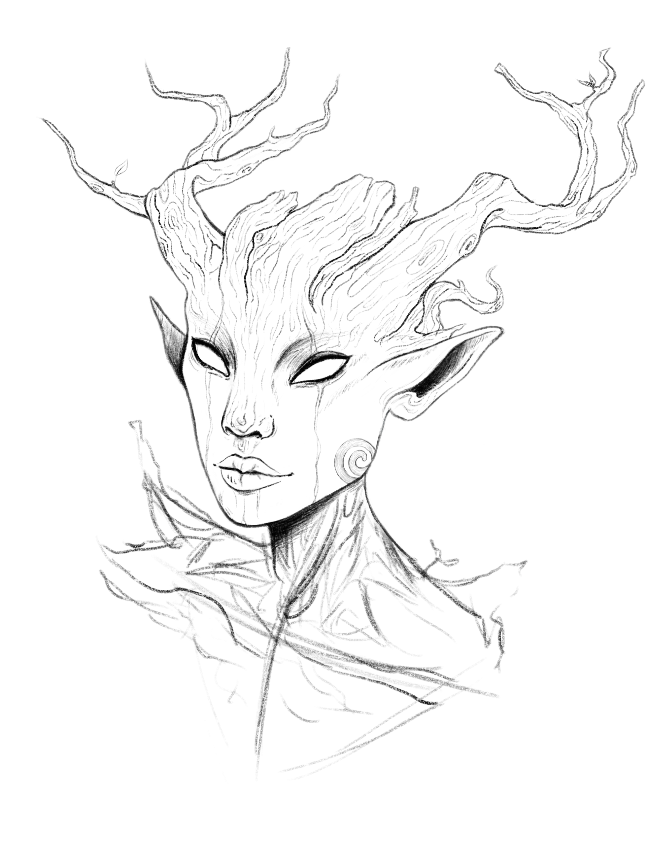
Verbeeg Lycanthrope
Verbeeg are giants that resemble oversized humans with gangly limbs and elongated faces. Thanks to their similarity to normal humans, the verbeeg were genetically susceptible to all forms of lycanthropy, though they have been proven immune to the curse of the wereraven.
Giant Werewolves. Lycanthrope, specifically the curse of the werewolf, had an adverse effect on the verbeeg giants. A verbeeg afflicted with a curse of lyncanthropy would proved vile and violent, even more so than their traditional lycanthrope cousins. This more animalistic nature lent a verbeeg lycanthrope to act vile in or out of transformation, and attempt to spread the curse of often as possible.
Due to how dangerous a verbeeg lycanthrope often proved to be, the many clans and tribes of verbeeg had it ingrained into their traditions that the immediate eradication of any and all verbeeg lycanthrope, and normal lycanthropes by extension, was a must to protect the best interests of all verbeeg giants. This lead to verbeeg tribes actively hunting down and killing any member that became afflicted with the condition.
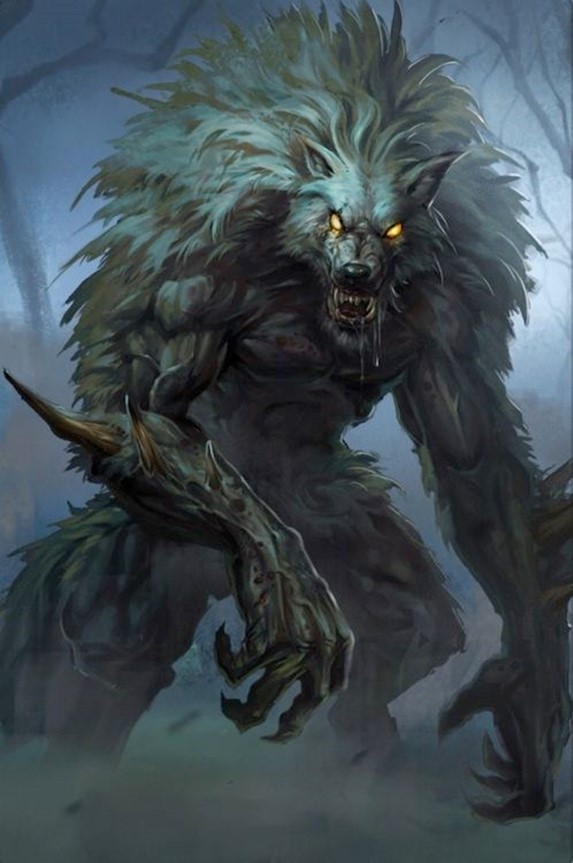
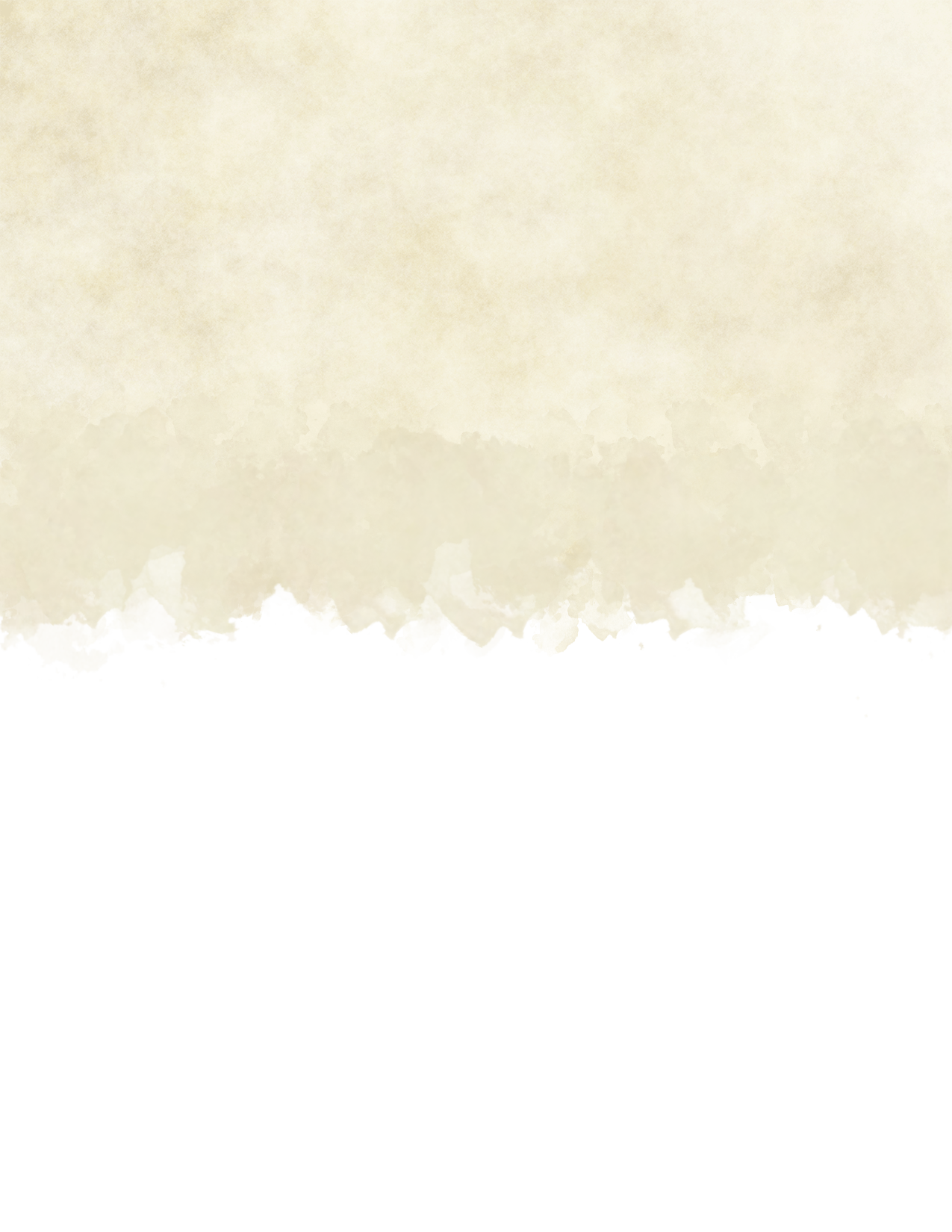

Verbeeg Lycanthrope
Large giant (giant, shapechanger), chaotic evil
- Armor Class 14 (hide armor, shield) in giant form, 15 (natural armor) in dire wolf or hybrid form
- Hit Points 85 (12d10+36)
- Speed 40 ft. (50 ft. in dire wolf form)
STR DEX CON INT WIS CHA 20 (+5) 11 (+0) 16 (+3) 11 (+0) 10 (+0) 9 (-1)
- Saving Throws Dex +2, Con +5
- Skills Animal Handling +2, Athletics +6, Perception +4, Stealth +2
- Damage Immunities bludgeoning, piercing, and slashing from nonmagical attacks that aren't silvered
- Senses passive Perception 14
- Languages Common, Giant (can't speak in dire wolf form)
- Challenge 7 (2,900 XP)
Shapechanger. The verbeeg lycanthrope can use its action to polymorph into a dire wolf-giant hybrid or into a dire wolf, or back into its true form, which is giant. Its statistics, other than its AC, are the same in each form. Any equipment it is wearing or carrying isn't transformed. It reverts to its true form if it dies.
Keen Hearing and Smell. The verbeeg lycanthrope has advantage on Wisdom (Perception) checks that rely on hearing or smell.
Simple Weapon Wielder. A simple weapon deals one extra die of its damage when the verbeeg lycanthrope hits with it (giant form, included in the attack).
Actions
Multiattack (Giant or Hybrid Form Only). The verbeeg lycanthrope makes two attacks: two with its spear (giant form) or one with its bite and one with its claws (hybrid form).
Bite (Dire Wolf or Hybrid Form Only). Melee Weapon Attack: +5 to hit, reach 5 ft., one target. Hit: 18 (3d8+5) piercing damage. If the target is a humanoid, it must succeed on a DC 12 Constitution saving throw or be cursed with werewolf lycanthropy.
Claws (Hybrid Form Only). Melee Weapon Attack: +5 to hit, reach 5 ft., one creature. Hit: 17 (5d4+5) slashing damage.
Spear. Melee or Ranged Weapon Attack: +7 to hit, reach 5 ft. or range 20/60 ft., one target. Hit: 15 (3d6+5) piercing damage, or 18 (3d8+5) piercing damage if used to make a ranged attack or used with two hands to make a melee attack.
Credits
Created by Nicholas H.
Contributors: ___
Proofreaders/Balancers: /u/lidanma, Nicholas H.Art in Order of Appearance
"Kangrinboqe Warrior" by yinyuming
"Giant castle" by Paul Chadeisson
"Craa'ghoran Giant" from the Monster Manual IV by Wizards of the Coast
"Shadow giant" by Tsabo6
"Sand Giant" by Mathias Kollros
"Eldritch Giant" by Lucio Parrillo for WotC
"Geriviar" by Wayne England for WotC
"Ondu Giant" MtG Art from Rise of the Eldrazi by Igor Kieryluk
"4e Hill Giant" owned by WotC
"Monster Compendium: Monsters of Faerûn" p. 50. owned by WotC
"sketch of a Spriggan" by allthingstamriel
"Fenric Gore-Claw" card from Heros of Camelot